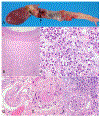Eosinophilic aortitis with thoracic aortic aneurysm and rupture in a captive-born owl monkey
- PMID: 30187922
- PMCID: PMC11025315
- DOI: 10.1111/jmp.12373
Eosinophilic aortitis with thoracic aortic aneurysm and rupture in a captive-born owl monkey
Abstract
Eosinophilic aortitis is a rare condition in animals and humans, and it has been occasionally reported associated with parasitic migration and with a poorly understood complex group of autoimmune vasculitides. Here, we describe a case of eosinophilic aortitis with thoracic aortic aneurysm and rupture in a captive-born owl monkey and discuss the differential diagnoses.
Keywords: Aotus nancymai; aorta; arteritis; autoimmune; eosinophil; granulomatosis; nonhuman primate; vasculitides.
Published 2018. This article is a U.S. Government work and is in the public domain in the USA.
Figures

References
-
- Albert DL, Brodie SJ, Sasseville VG, Ringler DJ. Peripheral blood eosinophilia in owl monkeys is associated with increased eosinophilopoeisis yet depressed recruitment kinetics to the Chemokine RANTES. Blood 1996; 88(5):1718–1724. - PubMed
-
- Animal Welfare Act as Amended. 2013. 7 USC § 2131-2159.
-
- Animal Welfare Regulations. 2013. 9 CFR § 3.75-3.92.
-
- Baer JF, Gibson SV, Weller RE, Buschbom RL, Leathers CW. Naturally occurring aortic aneurysms in owl monkeys (Aotus spp.). Lab Anim Sci 1992; 42(5):463–466. - PubMed
Publication types
MeSH terms
Grants and funding
LinkOut - more resources
Full Text Sources
Other Literature Sources

